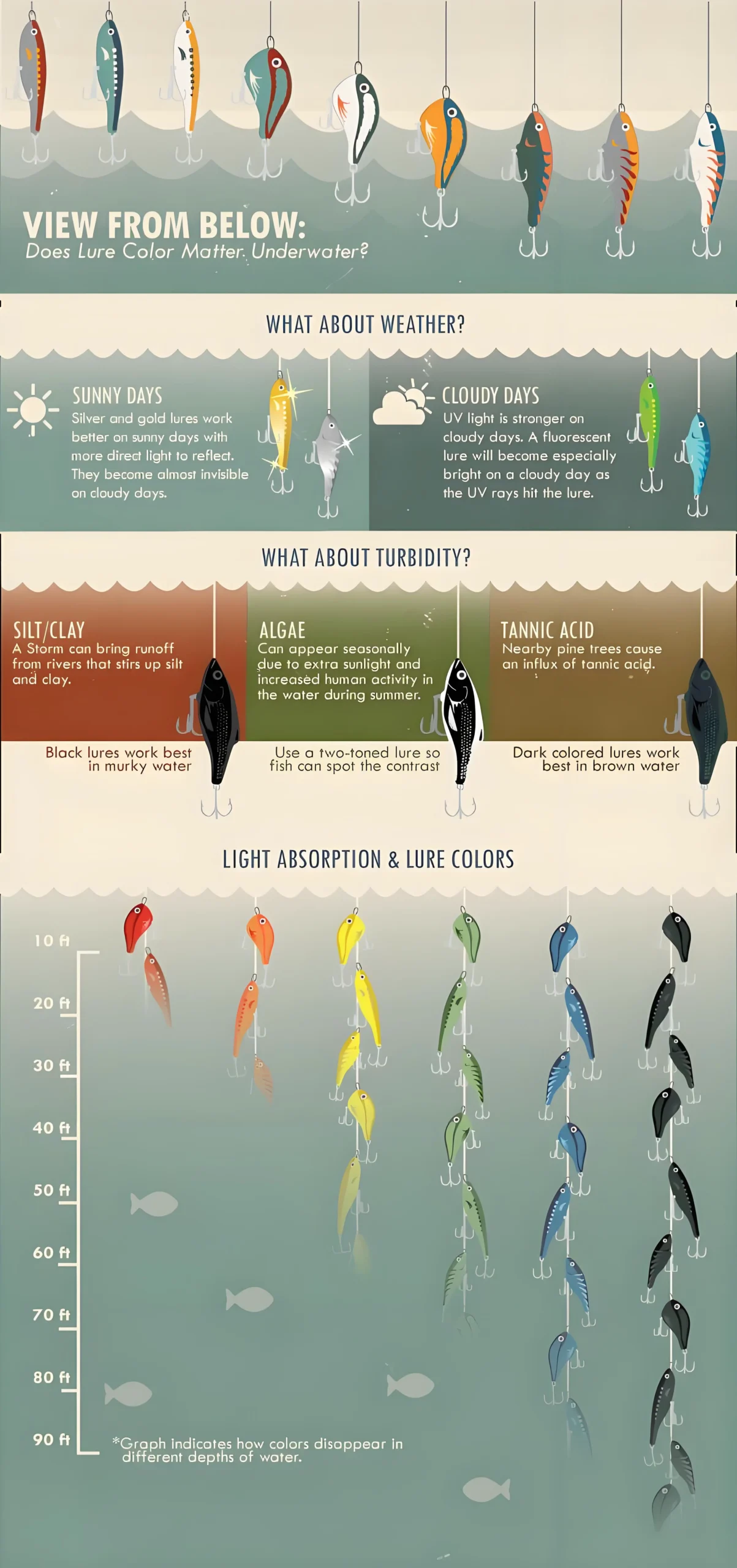
Ever found yourself pondering, “What colors of fishing lures work best in different water conditions?” You’re in excellent company! Selecting the right lure color can greatly influence your success on the water. In this comprehensive guide, we’ll explore the science of light and water color interaction, provide real-world scenarios to illustrate effective strategies, and match various lure colors to specific conditions. Plus, we’ll share some DIY testing tips to discover your personal go-to palette. Let’s dive in!
1. The Importance of Color: Light, Depth, and Turbidity
1.1 Light Absorption in Water
Did you know that water absorbs long wavelengths (like reds and oranges) quickly while shorter wavelengths (like blues and violets) penetrate deeper? Practically speaking, at depths of just 5-10 feet, reds can appear gray or disappear altogether, leaving blues and greens as your best options.
1.2 Clarity and Turbidity
- Clear Water (visibility > 3 m): Lure colors appear true, allowing fish to inspect details closely.
- Stained Water (visibility 1–3 m): Color saturation is essential; opt for higher contrast.
- Muddy Water (visibility < 1 m): With low light levels and suspended particles, focus on silhouettes and fluorescent colors.
1.3 Depth vs. Distance
When casting horizontally in clear water, color fidelity diminishes, similar to when sinking vertically. Always consider both factors in your lure selection.
1.4 UV and Fluorescent Lures
Many predatory fish can see into the UV spectrum, making UV-reactive and glow-in-the-dark finishes advantageous, especially in stained or dark water.
2. Color Matchups: Best Choices by Water Type
2.1 Crystal-Clear Shallow Water (> 3 m visibility)
- Top Choices: Natural patterns such as silver shad, bone, or translucent finishes.
- Why: They closely mimic forage fish. In ultra-clear environments, fish can be skittish; bright or unnatural hues can lead to spooking.
Bonus Tip: Use subtle UV highlights to enhance appeal without being overwhelming.
2.2 Clear Deep Water (1–3 m visibility)
- Top Choices: Dark-backed or bright-bellied combos, like black/chartreuse or blue/white.
- Why: Dark tops create silhouettes against the surface, while lighter bellies stand out against deeper waters.
Bonus Tip: Employ slow-rolling blades or jerkbaits with soft rattles to attract fish from a distance.
2.3 Stained Shallow Water (1 m–< 3 m visibility)
- Top Choices: Colors like chartreuse, fire-tiger, hot pink, or bright orange.
- Why: High-contrast colors pierce through murky waters, making them highly effective.
Bonus Tip: Opt for larger profiles and slower retrieves to help fish locate the bait through vibration.
2.4 Murky Deep Water (< 1 m visibility)
- Top Choices: Solid black, solid white, and metallic silver/gold.
- Why: A strong silhouette and reflections from white and metallic lures catch attention, even in minimal light.
Bonus Tip: Use larger spinnerbaits or deep-diving crankbaits with heavy rattles to provide both sound and flash.
3. Matching Lure Types with Colors
- Crankbaits & Jerkbaits: For clear water, stick with subtle shad patterns; in stained water, go bright with fire-perch or chartreuse.
- Spinnerbaits & Bladed Jigs: In clear water, use silver blades with white skirts, while gold blades and chartreuse/orange skirts perform well in muddy water.
- Soft Plastics: Clear water calls for natural colors like pumpkinseed; stained water benefits from electric chicken or motor oil with green flake.
- Topwaters: Use bone/white or realistic patterns in clearer conditions, while black/blue or bright green hollow-bodied frogs shine in stained waters.
4. DIY Test: Finding Your Ideal Color Palette
Step 1: Field Test
Prepare 4–5 contrasting colors and spend about 10–15 minutes per color in the same spot, tracking bites per minute.
Step 2: Photo Experiment
Attach lures to a line, submerge them at various depths, and photograph with your phone to see which hues stand out best.
Step 3: Cross-Condition Check
Return during varying light conditions (cloudy vs. sunny) or after rain to observe any performance changes.
5. Common Myths & Pro Tips
- Myth: “Brighter is always better.” In crystal-clear waters, neon lures may frighten cautious fish.
- Myth: “Stick to one favorite color.” Conditions can change rapidly; having a diverse tackle box ready is essential.
Pro Tip: Declutter your arsenal — build a collection with natural, contrasting, UV, and metallic colors to handle any situation that arises.
6. Putting It All Together: Action Plan
- Assess: Evaluate water clarity, depth, and light conditions.
- Select: Choose your base color scheme: natural for clear waters, high contrast for stained, and silhouette/flash for muddy.
- Animate: Adapt your retrieve speed and lure action to match the mood of the fish — aggressive or sluggish.
- Adjust: If bites are slow after 15 minutes, switch up your color family before the spot cools off.
Ready for Success?
Now that you understand “What colors of fishing lures work best in different water conditions?” you’re equipped with the confidence to select the perfect lure every time you hit the water. Tight lines and big smiles are right around the corner! 🎣
FAQs
Q: Why does color matter when fishing?
A: Fish see different colors depending on water conditions, so the right color can attract them more effectively.
Q: Should I change my lure color throughout the day?
A: Yes, as lighting and water conditions change, so should your lure colors.
Q: How can I test which color works best?
A: Conduct field tests and take photos underwater to gauge which colors stand out in your specific conditions.
Recommended Articles for Further Reading
- How Weather Affects Fishing: What Every Angler Should Know to Improve Your Catch Rate
- Mastering Weather Patterns: Why Fish Bite More in Certain Conditions
- Catching Bass Like a Pro: Proven Strategies and Techniques for Success
- Understanding Fishing Lures: Your Essential Guide to Choosing and Using Lures for Every Fishing Adventure
- Understanding the Science Behind Fishing Lures: How They Attract Fish and Enhance Your Fishing Experience
